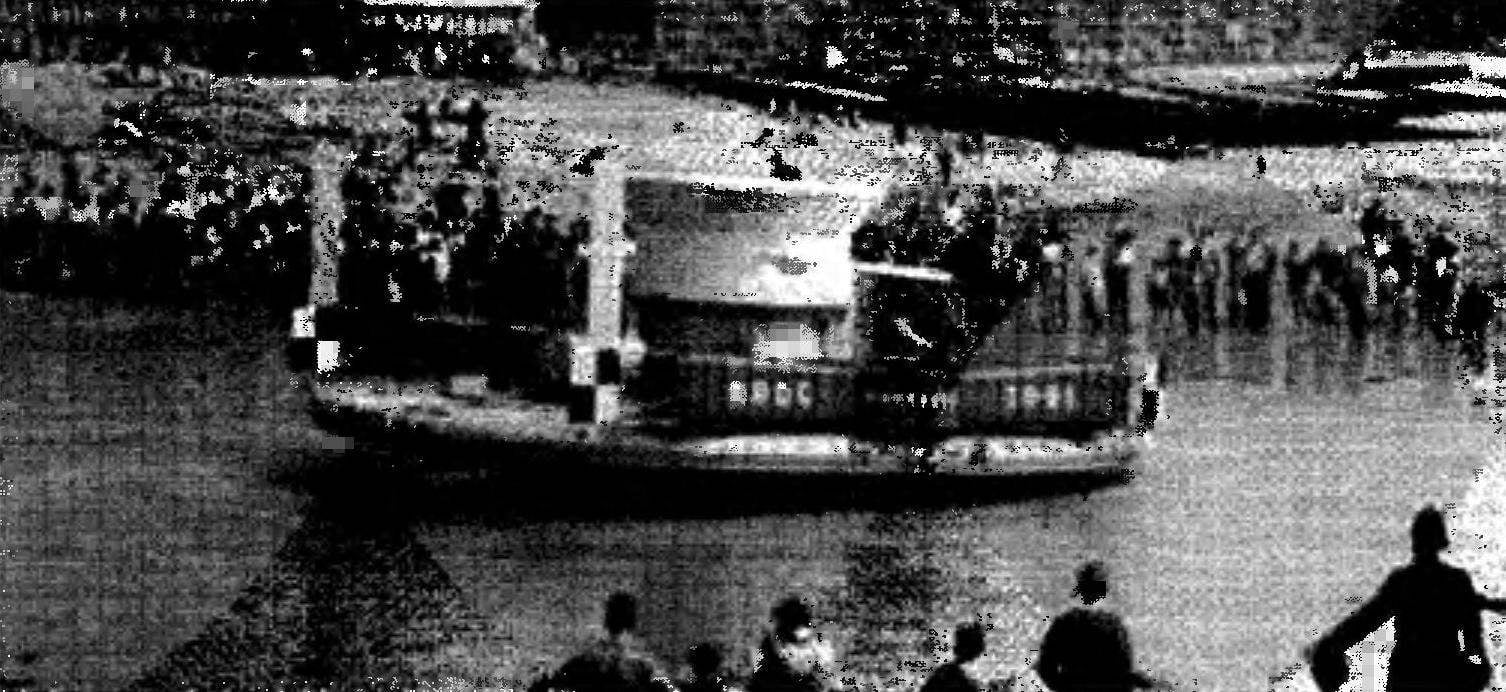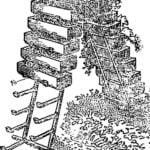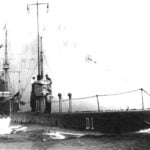 Ships rise into the air. From the moment when the English hovercraft (SVP) CR.N1 in July 1959, crossed the 32-mile Strait of Dover (or the better-known us — Pas-de-Calais) between the ports of Calais on the French coast of continental Europe, and Dover on the island Kingdom, its inventor Christopher Cockerell became famous all over the world…
Ships rise into the air. From the moment when the English hovercraft (SVP) CR.N1 in July 1959, crossed the 32-mile Strait of Dover (or the better-known us — Pas-de-Calais) between the ports of Calais on the French coast of continental Europe, and Dover on the island Kingdom, its inventor Christopher Cockerell became famous all over the world…
Mr. Cockerell — mechanic engineer of the company “Marconi” and, like most Englishmen, — a passionate lover of water-motor sports. Accumulating the necessary capital, he purchased a small shipyard and organized the construction of boats and their hire. It is known that, thinking about saving fuel and increasing speed boats to survive in the competition, Cockerell studied monograph of his contemporary and compatriot hydrodynamics D. Taylor’s “Speed and power of ships”. In it a scientist, in particular, analyzed is known, but unsuccessful attempts to reduce hydrocortisone displacement hulls by forcing air under them and gave suggestions for overcoming them.
It seems that Cockerell not left without attention and the other works of his compatriot scientist V. Froude, who in 1875 also studied the issue of the use of “air lubrication” is the thin layer of air injected between the hull and water. And the body itself, according to the scientist, was to have a cool bottom, like a floating battery, built by the Russian Admiral shipbuilder A. A. Popov shortly before. Based on the findings of scientists Cockerell began to experiment. After several unsuccessful experiments, he managed to get to “hang” the machine in the air. Well, to force it to move progressively was, as they say, a matter of technique. The essence of the experiment, you can demonstrate the following experience. In a tin can (for example, out of canned food) to insert another smaller (say coffee) and bond both containers. With constant injection of air by a fan through a flexible hose-the air in the space between the outer and inner hulls of the apparatus will rise above the floor and will stay in the air. If you place the camera on top of the scale, they show that the pressure on them will be approximately one third of which will create a fan.
In 1956, the English Ministry of supply, intrigued by the idea of Cockerell, coded it, and the next year suggested that the firm “Saunders-Po” (Saunders-Roe) to undertake the necessary preliminary studies and experiments. Their results were encouraging. In 1958, the invention has come to the attention of the National Corporation on research and development (NRDC). This organization has created a new company “Hovercraft development” (Hoverkraft Development), has entered into competitive contracts for the design of prototypes of hovercrafts with firms “Saunders-Po”, “Vickers-Armstrong” and “Danny.”

“Ballooning” cans—experience supporting idea C. Cockerell:
1—scales; 2—air blower; 3—rack; 4—nozzle; 5—outer shell; 6—inner housing

English inventor of the hovercraft K. Cockerell with his radio-controlled model
The most prepared of them were “Saunders-Po” (in 1959, became part of the company “Westland”), Just eight months later, she presented his hovercraft — SR.N1. After a successful test, which was almost immediately reached the estimated altitude over the ground surface 0.3 m show took place at the new public. June 11, 1959, businessmen and journalists have demonstrated a functioning RC model, and the boat, called “Hovercraft” (Hoverkraft — floating the ship). The unusual ship was launched and in the eyes of many spectators it has long hovered over the water (photo on the splash screen). Tests Jun 13, SR.N1 has a top speed of 25 knots, and a month later crossed the English channel (or rather Pas-de-Calais) — first from Dover to Calais on the ferry from Calais to Dover on their own. The transition lasted 2 hours and 3 minutes, ran the boat himself Cockerell…
The British press was quick to say that the English engineer invented a new previously unknown method of movement of vehicles, which promised not only high speed on the water (or rather, above the water), but even riding on land without roads: if only the terrain was not very rugged, but on the way met big unexpected obstacles, type of stumps or boulders, i.e., the apparatus had amphibious qualities. Successful transition of “hovercraft” through the English channel caused an explosion of excitement and enthusiasm among British citizens. About the hovercraft wrote poems and songs. However, meticulous technique historians have unearthed information that the first time the idea of “placement” of the air gap between the bottom of the vessel and the water surface to increase speed was expressed by the Swedish scientist Emanuel Swedenborg (Swedenborg) in 1716. But it is clear that the means to implement this idea at that time simply did not exist.
Preserved another interesting document — a report from 1853 architect Ivanov from Arkhangelsk in the name of the chief superintendent of roads and public buildings in Russia, in which the author proposed conceptual design “trekhmernogo of gogoplata” — ship, “which with the help of air it machine vgetarian air under his bottom can swim with considerable speed against the wind and the stirrup of the water.” The air was supposed to manually pump the bellows. In the early twentieth century another Swedish engineer Gustaf Laval conducted experiments to reduce the hydrodynamic resistance of ships by using the “air lubrication” is the thin layer of air injected between the hull and water. However, the practical positive results could not be obtained.

The hovercraft SR.N1:
1—the aerodynamic handlebar rear (2 PCs); 2—cabin of the pilot; 3—the air intake of the blower; 4—fuel tank 5—speed wheel forward (2); 6—housing; 7—deck; 8—nozzle thruster forward (2); 9—distribution front camera (or rear) of travel; 10 – distribution diaphragm (2); 11 —nozzle thruster reverse (2); 12—mooring device; 13–oil tank; 14 – blower; 15—channel selection of air to create thrust (2 PCs.)

The hovercraft SR.N1 during construction
In 1915, Lieutenant of the Austro-Hungarian fleet T. Von Mueller-Tummel designed the torpedo boat with the supporting effect of the airbag (see “modelist-Konstruktor” No. 4 of 1986).
Our great compatriot Konstantin Tsiolkovsky in 1927 published a paper “air Resistance and the Express train” in which he proposed to reduce impeding the movement of the train pumped under profiled the bottom of the cars… compressed air. While power was provided also with compressed air, produced through the holes of the nozzle.
This idea fascinated V. I. Levkov — a young Professor of hydraulics and aerodynamics (and soon professors) of the don (Novocherkassk) Polytechnic Institute. He confirmed her calculations and model tests — the usual inverted bowl with built-in electric fan, in front of astonished employees “soaring” and “floating” above the floor of the laboratory. Levkov has developed the dome circuit apparatus on an air cushion (WUAs). In 1935 — 1941 under his leadership, was designed and built several hovercrafts (SVP), of which the most famous torpedo boat L-5 (see “modelist-Konstruktor” No. 12 of 2005 and No. 10 in 1986).
It should be noted that all these devices work on the hovercraft was conducted in strict secrecy. Therefore, when the engineer Cockerell in 1956 he conducted a successful experiment similar to that V. I. Levkov has made thirty years ago is considered the inventor was granted a patent. However, to belittle the importance of the development of Cockerell in any case impossible.
Implementation V. Revkova during the great Patriotic war ended, and after the war they practically were not in demand and even forgotten, except for Amateur designer-student of G. S. Turkina, who in 1952 developed the WUA with the nozzle in the scheme (and in initiative order, or rather in the home, testing it on the streets of Moscow). Unfortunately Gennady Turkin in the midst of improvements to WUAs, died suddenly of heart disease, and followers, he was not.
Hovercraft SR.N1. The descent to the water. Two dark rings on the bottom—both the inner and outer nozzle


Hovercraft SR.N1 built by the firm “Sounded Ro”, piloted by K. Cockerelli, makes a transition through the Strait of Pas-de-Calais
Quite a different fate awaited the Ноvеkraft (“hovering vessel”) sir Cockerell. The new ship was widely publicized, about the structure of her work — published scientific information. And because the transition SR.N1 from Calais to Dover was not only a landmark event of the birth of the SVP, but as of now decided a new direction in the shipbuilding world. Ноvеkraft pushed in the activation of similar works in this direction in many countries, not to mention England.
But despite such enormous success, further improvement SVP at first seemed to have stalled. The fact that the maximum acceptable installed power of the vessel (the capacity of the ventilation unit) can ensure the rise above the surface no more than 0.3 m, which was not enough to ensure a decent seaworthy and permeability. However, designers fairly quickly and successfully coped with this problem and in 1960 took the easy way out — SVP SR.N1 set “skirt”, which is a flexible fencing (GO) stretch-rubberized fabric around the perimeter of the bottom of the vessel. The height of the cloth fence was about 150 mm. Theoretical calculations and experiments have shown that with the same power a hovercraft with a flexible enclosure can rise above the supporting surface to a height of up to 8 times greater than without.
Further research and experimental work was aimed at improving lifting and carrying (NCP) and the propulsion and steering (DRC) complexes, as well as to reduce the cost of SVP.

The airflow pattern of SVP SR.N1:
and—sucked-in outdoor air; b—the device of reverse thrust;—the direction of the current of the air curtain; g—air flow of the outer nozzle
At the first stage the leaders in the development of MRAs in the West remained British. In 1964 in the UK, the firm was created by the British Hoverkraft Corporation. She received international fame as the developer and Creator of the series hovercraft from a mild SR.N5 to a large EXT.7 and ferries SR.N4.
Machine air cushion of this company worked as on domestic routes between the British Isles and the lines cross the channel (since 1966) and even carried out the transportation in the Arctic circle in Northern Norway for the needs of NATO. In 1969, a multipurpose hovercraft SR.N6 (a modification of the SR.N5) was carried out using TRANS-African expedition Senegal, Mali, Niger, Nigeria, Cameroon and the Congo.
A different approach to the implementation of programs for the creation and development of the SVP was implemented in the United States and Canada, with the main core areas-developed transport network. At first they were purchased English SVP SR.N5, SR.N6 and SK.N5 for large-scale testing in the harsh conditions of Alaska and the polar regions of Canada at ambient temperatures of up to -30°C and a wind speed of 20 m/s.
Test for patency was performed at the limit of technical capabilities of hovercraft. The car crossed the snowdrifts in height to 1.8 m, and ascended and descended on gradients up to 6°, passed over the hummocks height up to 0.9 m.
During the tests, the machine was brought to seismic, hydro – and geoloogiakeskus works. During this period, they participated in the military actions of the US in Vietnam.
In the late 1970-ies the American company Aerojet Marine Equipment and Bell Aerospace Textron has built and submitted for competition tests, respectively SVP JEFF(B) JEFF(A).
Preference is given to JEFF(B) Bell Aerospace Textron, which began serial production of the type LCAC hovercraft for the US Navy. JEFF(A) zafrahtovalo the British Petroleum company for testing of oil development on Northern Alaska.
In Canada, the company Bell Aerospace Canada Textron in 1971 built cargo SVP civil use Voyager (“Voyager”). Three years it was tested to the limit in terms of the North American Arctic, and only then recommended as a prototype for serial production of SVP-lighters LACV-30 (Lighter Air Cushion Vehicle) with a lifting capacity of 30 t Main customer of the lighters were made by the U.S. Navy.
In Japan, the work on creation of units VP led the company Mitsui Engineering. She started with the fact that he signed a licensing agreement with British companies Hoverkraft Development and Vickers, who took part in the competition to create English SVP. Licensed a Japanese firm built a small series of SVP of various displacement and passazhiroemkosti: MV-PP1, MV-PP5, MV-PP15. Japanese shipping company Oita Hover Ferry successfully exploited MV-PP5 in the coastal waters on a line between the city of Oita airport.
Later, the firm Mitgui Engineering developed a passenger hovercraft MV-PP10, then stopped work in this direction.
France in the development of SVP civil purposes and went his way. Since 1968, the firm Sedam built a number of machines adapted to travel on water and by land under the name of Naviplan (No. 101, No. 102S, NO. 102L, No. 300). A distinctive feature of the French SVP was the application to them of the original FIRST multi-type company Societe Bertin.
The greatest achievement of the French was the construction of two ferries Naviplan 500. But one of them burned down during the factory test and the other, having worked in 1978 on the Dover — Boulogne across the English channel, was withdrawn from service because it could not compete with English SR.N4.
Starting a conversation about Chinese hovercraft, it should be noted that for the hovercraft all the countries were characterized by high-power as the power units they used aircraft engines (both piston and gas turbine) ship hulls made out of aircraft materials.

Hovercraft SR.N1 in the “skirt” comes ashore
In China began to show interest in SVP only in the mid 1970-ies, when the majority of the above countries began to move to the creation of a SVP of the 2nd generation, built to naval technology diesel engines.
The story of the creation of SVP in the Soviet Union began as if anew.
In the early 1960-ies in Leningrad (now St. Petersburg) shipbuilding Association “Diamond” has developed, built and tested a 5-seater hovercraft “rainbow” and 38-local — “Neva”. Despite their many shortcomings, the tests of these MRAs have proved the possibility of creation of the world level on the basis of domestic equipment and technology from domestic materials and components, though mostly quite expensive — aircraft.
In 1965 the plant “Red Sormovo” in Gorky (now Nizhny Novgorod) built 50-seater passenger hovercraft “Sormovich”. Frequent operating troubles especially in structurally complex powertrain, consisting of four gears, did not stimulate further development in the USSR this type of vessels, and because there was a pause of several years.
However, the experts had acquired the necessary experience and capabilities of the SVP was brought to the attention of the interested ministries and departments.
In the early 1970-ies in the USSR was built from three small SVP: Briz — marine Association “Almaz”; “rainbow-2” — factory “Red Sormovo” and AACVPR (amphibious boat on air lo-Dusko reactive) — CDB “Neptune” in the town of Dolgoprudny in the Moscow region.
The most successful of them — built in 1976, AACVPR. He became the prototype of the production SVP type “bars”, which, in turn, is the basis for “Cheetah”, which poured into the “Puma” which translated to “IRBIS”. “Puma” still had the body made in aviation technology, but gazovskih diesel car engine ZMZ-408. IRBIS became SVP of the second generation. He had two diesel engines and the casing is made at a cheaper shipbuilding technologies and related materials.
But this is not talking about the creation and development of hovercraft — the theme of the volume, and therefore require a separate consideration.
A. POLIBIN, M. YAGUBOV



